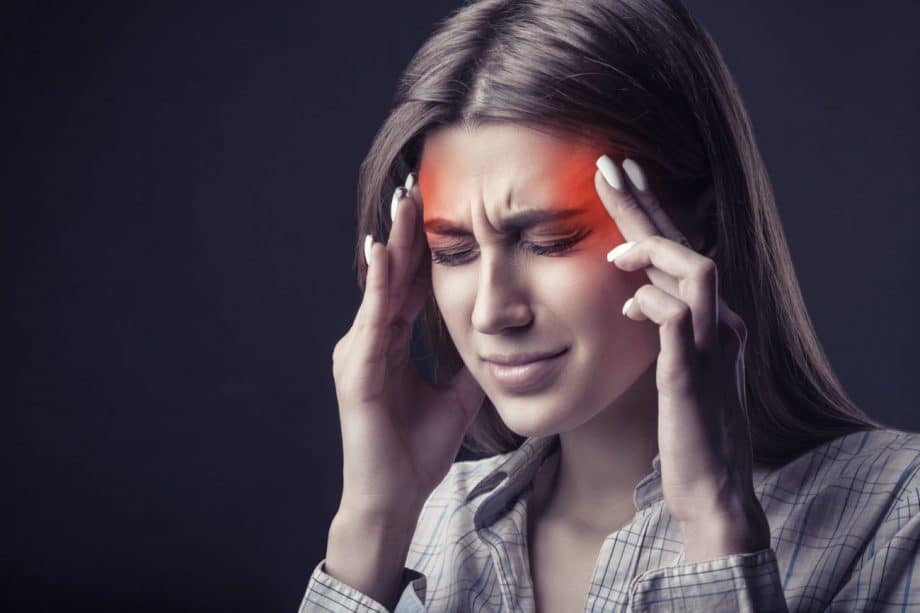Last month, we focused on discussing the 10 Most Common Symptoms of TMJ Disorder and then breaking down the face symptoms in particular.
But if you have experienced or know someone who has experienced TMJ pain, you know that there are more symptoms than just the face region. Or if you don’t have this experience, then reading our previous post on the 10 most common symptoms would reveal this truth to you as well.
Today, our focus will be on breaking down the symptoms in the head and other extremities:
- Headaches
- Dizziness & Balance Problems
- Pain in the Upper Back/Neck
- Tingling or Numbness in Fingers
Our goal is to explain why your temporomandibular joint (TMJ) is causing these types of symptoms and how your body really is all interconnected. Let’s get started!
Headaches
TMJ headaches may sometimes be difficult to differentiate from normal headaches, but the cause is very distinct. The muscles of the temporomandibular joint run along your jaw and cheek. When your jaw muscles tense up, this pain can spread to other muscles alongside your cheeks and the top and sides of your head. This chain reaction is what causes TMJ headaches.
While TMJ headaches may feel like other headaches, TMJ headaches do often occur with one or more other symptoms, such as:
- Tight facial or jaw muscles
- Facial or jaw pain
- Restricted movement in your jaw (opening and closing your mouth is difficult)
- Clicking or grinding noise in your jaw
Dizziness & Balance Problems
According to The TMJ Association, “[temporomandibular dysfunction] (TMD) patients sometimes report feeling dizzy or experiencing an uncomfortable whirling sensation throughout their bodies.” The latter half is one of the classic symptoms of vertigo and may actually be accompanied by one or more of these symptoms as well:
- Confusion or Disorientation
- Sensation that objects are moving
- Feeling of falling
- Difficult balancing
- Lightheadedness
Although dizziness might seem like an odd symptom to occur from the jaw area, it makes sense when you look at how interconnected the body truly is.
The ear is only an inch away from the temporomandibular joint (TMJ) so if inflammation from the TMJ travels to your middle or inner ear, it can affect your balance. There are tiny structures within your ears that regulate your sense of position—any inflammation in your ear can then cause vertigo or balance problems such as dizziness.
Pain in the Upper Back/Neck
If you’ve been reading our last few posts, you most likely realize and understand just how closely the body is connected, especially the head, neck, face, and jaw areas. The temporomandibular joint connects the jawbone to the skull. This means that surrounding areas such as the neck and upper back are going to be greatly affected by any disturbance in the jaw—which is exactly what happens with TMJ pain and dysfunction.
Inflammation in the jaw area can spread into muscles and other connective tissues, causing a tight, dull aching sensation in surrounding areas. These areas include the shoulders, upper back, and neck. One rule of thumb is that the muscle aches are usually on the same side as the affected jaw in the TMJ. If both jaws are affected, then aches can occur on either or both sides.
Tingling or Numbness in Fingers
While tingling or numbness is one of the lesser symptoms out of the 10 from our list, it’s still a big symptom. In fact, 1/3 of TMJ sufferers report paresthesia of the fingers. Due to the body’s vertical build, the body is dependent on having proper balance and alignment. So, when one thing is out-of-line, the body tries to compensate somehow to remain in equilibrium.
An example could be tilting of the neck or shoulders to create an even balance, which sounds great. Well, until this compensation creates pinching of the nerves in your arm, causing numbness and tingling in your fingers or hands.
The good news with the fact that the body is so inter-connected, especially the temporomandibular joint, is that just like pain in the jaw area can affect many other parts of the body, fixing the problem in the jaw area can cause relief to the other parts of the body too.
We have helped dozens of our patients find relief from the pain they’re feeling. We’ve created and delivered customized, personal solutions for symptoms such as those mentioned in this post and many others. The key for us is to diagnose the root cause of the problem and fix it—not just mask the symptoms.
We at TMJ+ believe in taking a holistic approach to treating your TMJ pain. We are proudly serving the Grapevine and DFW area and would love to help you find the best treatment plan for you! Contact us today to schedule your free consultation with one of our TMJ experts!
993 total views, 9 views today

